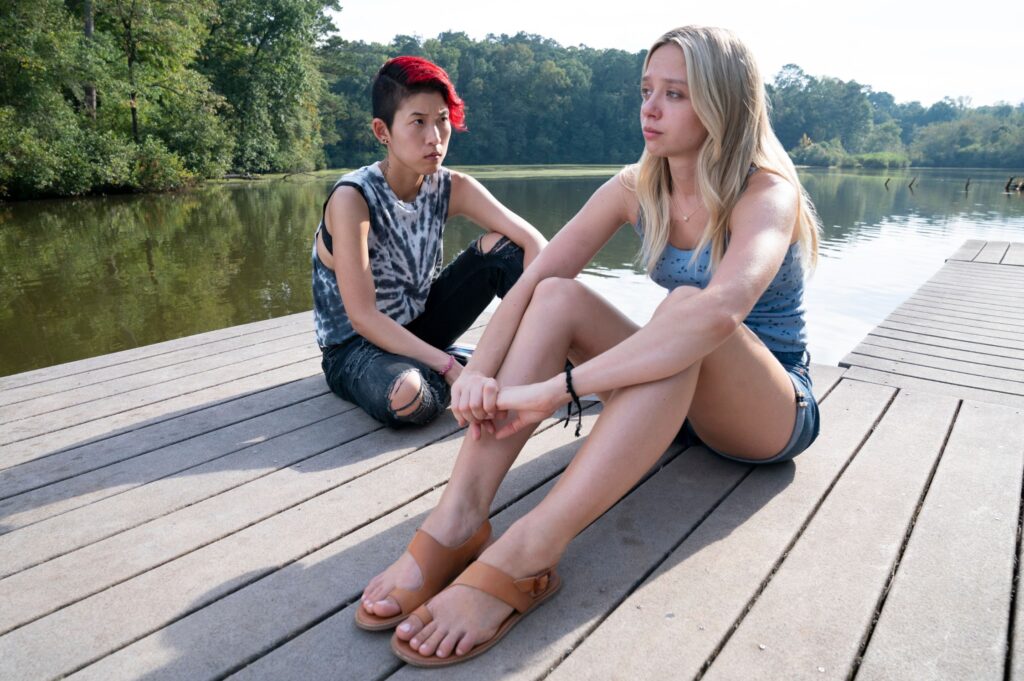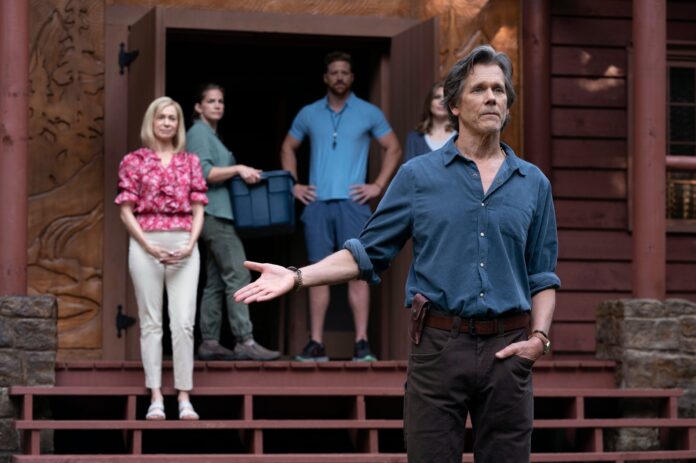Out gay writer John Logan — he was Oscar-nominated for “Gladiator,” “The Aviator” and “Hugo” — tackles both horror films and the horror of conversion therapy camps with his terrific directorial debut, “They/Them.” Out August 5 on Peacock, the film has a dozen LGBTQIA+ youth entering Whistler camp to change their sexual and gender identities. The youths include Jordan (Theo Germaine) who is trans, Stu (Cooper Koch), a gay swimmer, Veronica (Monique Kim), a bisexual, and Kim (Anna Lore), a lesbian, among others. The camp director, Owen (Philly native Kevin Bacon) wants them to “find their own truth,” with activities such as pie-making for the females, and target shooting for the males. While the adults want to reinforce traditional gender roles, the real concern is: Who is the masked killer taking out folks at the camp?
PGN spoke with Logan about his nifty thriller, “They/Them,” aka “They slash Them.”
Your screenplays may have had little queer tinges to them, but this is your first full-on gay project. Why did you choose to write and direct “They/Them,” and queer things up now?
I have had a queer career before this. The first play I ever wrote was about the Leopold and Loeb, when I was 18, which definitely dealt with queer issues. And one of the things I’m proudest of, in “Skyfall,” was bringing homoeroticism to the Bond franchise, so, it’s never something I’ve shied away from. But this movie was very personal to me. When I was growing up, there were no gay characters in horror films. And if they did exist at all, they were jokes, or victims, or killers, never the hero. I know how much it would have meant to me to see a horror movie with queer hero.
I thought your opening scene was a brilliant send up of the trope, but so too was the shower sequence. Can you talk about leaning into the horror genre, but also queering it up?
That was the game of the movie. I wanted to fully embrace every trope from the slasher movie — the camp in woods, the killer with the mask, and the sense of dread, the soundtrack, the crickets, the darkness, a killer who uses different weapons — but then use them for the angels. The kids are not running in terror. They are not being slaughtered. They are the heroes who are fighting and surviving. The shower scene, for example, has a traditional buildup of suspense. You think there’s going to be a horrific murder here, and this beautiful woman is going to be killed, but we used it for an entirely different kind of horror and shock. All the way along, I tried to play with and enjoy those expectations of a traditional slasher film and find a queer twist.

I appreciated that the queer characters all had agency and you had a diverse cast. What decisions did you make regarding LGBTQ representation?
It was super important to me to have a queer cast. We have been so underrepresented, particularly playing ourselves. I felt it was important in a movie about people’s identity being assaulted that they had a very strong and prideful identity. I only wanted LGBTQ+ actors for those roles. I worked with them closely. I am not nonbinary. I’m not trans. These are 20-year-olds. They are different from me. It was an ongoing dialogue. Before it was cast, I worked with GLAAD and Scott Turner Schofield [executive producer] to understand the language and be sensitive to the issues. I worked with Theo Germaine — tell me what’s not right or authentic. No writer wants to write a cliché, or deal with serious issues like these in anything less than serious or responsible way.
What did you consider when you focused on the conversion therapy elements of “They/Them”?
I talked to people who have been through conversion therapy, and it is a monstrous evil, and it is legal in half the United States. And the big bad is the idea of taking a human and unmaking them — turning them into something else. It was important for me to present that authentically, and not shy away from horrors of what these places are because they are horrific. These places exist all over this country and all over the world.
This is a horror film where there is some mild graphic violence but not many jump scares. Can you talk about creating the tone?
Not all horror movies are drenched in blood. Some have no blood whatsoever. When you talk to people who have gone through the so-called gay conversion camp experience, there is physical suffering — there is sleep deprivation, forced marches— but it’s the psychological drama that is most destabilizing. The true horror isn’t the ax, or the killer, it is what counselors are doing to these kids — they try to take away their individuality and make them something they are not. The movie wanted to lean into the thriller intention, not graphic violence; it can be pornographic if not done responsibly, it can be excessive, it can be theatrical, and I wanted this to feel real about suffering the kids were going through and the dangers that they faced.
In the horror film genre, sex is usually punished by death. What can you say about the sex scenes in “They/Them?”
We have had 100-years plus of straight sex scenes and every conceivable shape and permutation. It’s about time we do that in queer cinema. General audiences realize that gay people have sex and it’s romantic or sexy or erotic or physical. This happens, and we can’t look away. I want to celebrate these beautiful people and their attractions to each other. In the traditional slasher film, if you have sex, you’re going to be punished for it. Because everything in this movie is seen through a twisted and changed queer lens, if you’re going to be punished for it, you are also going to become a hero for it, because you are going to survive and surmount the punishment heaped upon you.
What about the ideas of identity in the film? There are, of course, gender role activities used to “straighten out” the youth, but also an exuberant musical number set to Doylestown native Pink’s “Fuckin’ Perfect.”
That was the intention, to represent the queer experience from the most exuberant — singing and dancing in a musical number like on the Broadway stage — to the romantic and the erotic and the sincere and genuine, and to represent that in an authentic way for these characters within the shell of threating environment. The way queer people triumph is by celebrating themselves and their uniqueness. The film says there is power in uniqueness and there is power and glory to be found in just saying this is who I am, and I am fucking perfect just the way I am.

